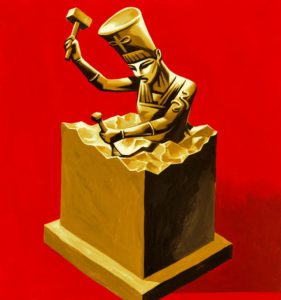WSJ Historically Speaking: Monuments With Staying Power

In Turkey, a subterranean strategy. ILLUSTRATION: THOMAS FUCHS
Mount Rushmore celebrates its 75th birthday this month, with many more to come, according to geologists: They estimate that the granite presidential faces will withstand the forces of erosion for 7.2 million years.
Poets have long bristled at efforts by the rich and powerful to immortalize themselves in stone. In “Ozymandias” (1818), Percy Bysshe Shelley portrayed such attempts as vainglorious and futile. All that remains of Ozymandias, king of kings, is “Two vast and trunkless legs of stone… Near them, on the sand, / Half sunk, a shattered visage lies.” The poem’s ironic message lies in the king’s inscribed command to “Look on my works, ye Mighty, and despair!” when all around there is nothing but empty sand.
But Shelley was too quick to dismiss the staying power of chiseled rock. Consider the fate of what is probably the oldest human monument, the stone temple of Göbekli Tepe in Turkey. A hunter-gatherer society erected this massive ring of T-shaped pillars in the 10th millennium B.C.
Defying modern assumptions about the limits of Stone Age know-how, the builders created a large complex, carved with extraordinary depictions of animals and insects. After two millennia of continuous use, Göbekli Tepe was abandoned, for some reason, around 8000 B.C. Before its users left, however, they carefully buried the megaliths, many of them almost 20 feet tall, under tons of rubble. Perhaps it was to protect the site, though no one knows. By disappearing from view, Göbekli Tepe survived unmolested and largely intact until its discovery in the 1960s.
Monuments that do get erased are seldom the victim of the mere passage of time; more active measures are usually required. Queen Hatshepsut (who reigned from 1473 to 1458 B.C., approximately) was the first female pharaoh of Egypt and one of the earliest victims of intentional obliteration. After her death, her stepson, Thutmose III, and others destroyed her statues and records and removed her name from every monument. Hatshepsut remained invisible until archaeologists in the 19th century stumbled upon her temple in the Valley of the Kings. Without that stroke of fortune, one of the greatest queens who ever lived would have remained invisible to history.
Even when monuments escape harm, they risk becoming unintelligible. In India, the Buddhist convert King Ashoka, who died around 238 B.C., proselytized his faith through sets of edicts that were carved in Brahmi script onto various cliff-faces and pillars. They included one of the earliest proclamations of religious freedom. But the power of Ashoka’s words to inspire was lost as the Brahmi writing system was superseded by others. No one could understand the edicts until James Prinsep, a 19th-century English scholar, used clues from other inscriptions written in Brahmi to make the first translation in over 1,000 years.
Perhaps the Roman poet Horace was right when he claimed in Book III of his odes: “I have built a monument more lasting than bronze.” The quickest way to immortality is through art.
